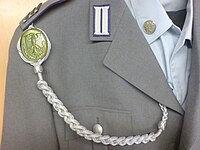German Armed Forces Badge of Marksmanship
The German Armed Forces Badge for Weapons Proficiency (German: Schützenschnur) is a decoration of the Bundeswehr, the armed forces of the Federal Republic of Germany.
The decoration is awarded to German military personnel of all grades, but is only allowed to be worn by enlisted members. The German armed forces regulations point out, that "the Schützenschnur is a decoration for weapons proficiency for enlisted soldiers." Officers can receive the award, although it is not currently authorized to be worn on their uniforms. Foreign military members also may be awarded the badge, the German military regulation on officers still applies, permitting only the enlisted members to wear the badge.
The history of the Schützenschnur dates back to the Eighty Years' War where Spanish troops were ordered to hang any Dutch person who carried a musket. Therefore Spanish musketeers began to carry ropes which were often carried over one shoulder. Awarding a cord as a decoration began in the early 18th century in Prussia under Frederick William I of Prussia.
With the reorganization of the Prussian Army under Gerhard von Scharnhorst the Schützenschnur became an official military award.
The Reichswehr and later the Wehrmacht adapted the Schützenschnur as an award for proficiency in marksmanship. The award existed in 12 different levels with different versions for infantry and armored troops.
In 1957 the Bundesgrenzschutz introduced the Schützenschnur.
A similar decoration existed within the East German National People's Army and the Border Troops of the German Democratic Republic.
To earn the award one must successfully shoot weapons from all three classes:
The awarded grade is determined by the lowest weapon qualification.(e.g. if you qualify all gold and one bronze, you are awarded the bronze.)
In the United States military, the German Armed Forces Badge for Weapons Proficiency (Schützenschnur) is one of the few pre-approved foreign awards, requiring no individual approval request to be forwarded up the serviceman's chain of command to the United States Senate for acceptance. Occasion and manner of wear of the Schützenschnur are governed by the individual services' uniform regulations (e.g., Army Regulation 670-1); such regulations additionally specify the placement of the concealed button on the uniform with which to affix the Schützenschnur's rope. Section 22-18 part b of the DA PAM 670-1 states the following.
...
Wikipedia

